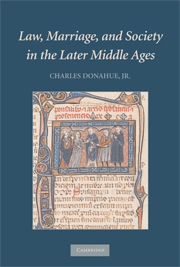Book contents
- Frontmatter
- Contents
- List of Tables
- List of Appendices
- Preface
- Acknowledgments
- Notes About This Book
- Introduction
- 1 The Background Rules and Institutions
- 2 Lying Witnesses and Social Reality: Four English Marriage Cases in the High Middle Ages
- 3 Statistics: The Court of York, 1300–1500
- 4 Story-Patterns in the Court of York in the Fourteenth Century
- 5 Story-Patterns in the Court of York in the Fifteenth Century
- 6 Ely
- 7 Paris
- 8 Cambrai and Brussels: The Courts and the Numbers
- 9 Cambrai and Brussels: The Content of the Sentences
- 10 Divorce a mensa et thoro and salvo iure thori (Separation)
- 11 Social Practice, Formal Rule, and the Medieval Canon Law of Incest
- 12 Broader Comparisons
- Epilogue and Conclusion
- Bibliography and Abbreviations
- Subject Index
- Texts and Commentary
- Table of Cases
- Table of Authorities
- Index of Persons and Places
8 - Cambrai and Brussels: The Courts and the Numbers
Published online by Cambridge University Press: 14 July 2009
- Frontmatter
- Contents
- List of Tables
- List of Appendices
- Preface
- Acknowledgments
- Notes About This Book
- Introduction
- 1 The Background Rules and Institutions
- 2 Lying Witnesses and Social Reality: Four English Marriage Cases in the High Middle Ages
- 3 Statistics: The Court of York, 1300–1500
- 4 Story-Patterns in the Court of York in the Fourteenth Century
- 5 Story-Patterns in the Court of York in the Fifteenth Century
- 6 Ely
- 7 Paris
- 8 Cambrai and Brussels: The Courts and the Numbers
- 9 Cambrai and Brussels: The Content of the Sentences
- 10 Divorce a mensa et thoro and salvo iure thori (Separation)
- 11 Social Practice, Formal Rule, and the Medieval Canon Law of Incest
- 12 Broader Comparisons
- Epilogue and Conclusion
- Bibliography and Abbreviations
- Subject Index
- Texts and Commentary
- Table of Cases
- Table of Authorities
- Index of Persons and Places
Summary
INTRODUCTION
In the late Middle Ages, the diocese of Cambrai was large. It extended from the county of Cambrai in the southwest, across a large swath in the central part of modern Belgium, to Antwerp in the northeast. It thus included, in addition to Cambrai itself, the towns of Valenciennes (Nord), Mons, the part of Tournai on the right bank of the Scheldt, and Brussels. A survey in the fifteenth century counted 1,029 parishes, divided into 18 deaneries and 6 archdeaconries. The official, who held court at Cambrai, was assisted by a delegate at Brussels. In 1448, the official at Brussels became an official principal, equal in rank to that at Cambrai. The jurisdiction of the official at Brussels covered the three northern archdeaconries, that of Antwerp, Brussels, and Brabant, roughly corresponding to the Flemish-speaking areas, while the official in Cambrai retained jurisdiction over the three southern archdeaconries, Cambrai, Valenciennes, and Hainault, roughly corresponding to the French-speaking areas.
These officialities have left a collection of registers of sentences, dating from the middle of the fifteenth century. Those from the city of Cambrai bear dates from 1438 to 1453, though there are gaps, while that from Brussels bears dates from 1448 to 1459 and seems to be complete. The sentences thus allow us to see the activity of the officials of Cambrai both before and after the division of the diocese and that of the officials of Brussels just after the division of the diocese.
- Type
- Chapter
- Information
- Law, Marriage, and Society in the Later Middle AgesArguments about Marriage in Five Courts, pp. 383 - 423Publisher: Cambridge University PressPrint publication year: 2008



